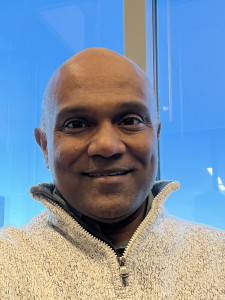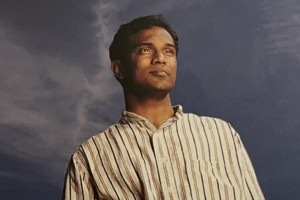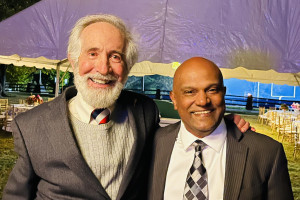"I wouldn't be living and working in the United States now if it weren't for Sewanee. It's almost miraculous that I ended up here. I'm eternally grateful."

Asitha Sandanayake, C’95, half-jokingly attributes his matriculation at Sewanee to “luck or divine providence.” As he describes the series of events that brought him to campus, it’s not a stretch to imagine that a Sewanee angel or two intervened. Sandanayake conducted his college search largely through word of mouth—by asking friends in his home country of Sri Lanka if they had any details about scholarship opportunities at American universities. One acquaintance told him that Sewanee had provided financial aid to Sri Lankans in previous years, so Sandanayake included the University among his applications. At the time, he had never traveled to the United States, let alone set foot on the Mountain.
Though Sandanayake was admitted to Sewanee and several other American institutions, he did not receive any scholarship funding. When a close family friend asked him about his college plans, he told her that he intended to study in Sri Lanka. “This was in mid-June or July,” he says. “Sewanee was due to start in the last week of August.” Sandanayake says his friend had significant financial means and was one of Sri Lanka’s few residents with a phone line capable of making international calls. She encouraged him to call Sewanee’s Office of Admission and inquire again about scholarships. “I called the admissions office in July, and they took my information and asked me to call back the next week,” he says. “When I called a week later, they told me they could provide nearly a full scholarship.”
Cue a “mad rush,” as Sandanayake says, to obtain his visa and complete other necessary paperwork. Though he missed freshman orientation, he arrived in time for the start of classes. “I knew very little about the campus—I just landed in Sewanee with a scholarship in hand,” he says.
Despite the swift transition, Sandanayake says his culture shock was minimal. As a high schooler, he had studied in Australia and lived on a farm in rural Tasmania. “That experience prepared me to live in a small town,” he says. “The bigger challenge was acclimating to Southern culture.” Though Sewanee was only moderately diverse in the mid-1990s, Sandanayake says, there was a solid group of international students, primarily from South Asia and Europe. Sandanayake found his niche in a campus multicultural society, the Organization for Cross Cultural Understanding (OCCU), which he led for two years. He also built friendships by spending time in the University’s language theme houses.

1995 issue of Sewanee magazine
As he broadened his social circle, Sandanayake looked for ways to share his culture with his American peers and the local Sewanee community. “Some friends and I received funding from the Activities Fee Committee to teach cricket,” he says. “It was a spring class, and we’d go outside to one of the campus fields and set up a pitch. Then, we’d split the class up and play a cricket match. That was a lot of fun.” He also sang in the University Choir, managed an intramural basketball team, and coached rugby. “Getting involved with the OCCU, teaching cricket, and coaching rugby—these things helped me make inroads with students who might not have had much prior exposure to people of color,” he says.
After earning undergraduate degrees in economics and physics, Sandanayake received a full scholarship to pursue a Ph.D. in applied economics at the University of Minnesota. While he was in graduate school, he got married, and his wife made plans to enroll in nursing school. To cover living expenses, he served as an adjunct economics professor at a small college in Northfield, Minnesota, for a semester. After his teaching position ended, he took an entry-level position at American Express.
As Sandanayake continued exploring career options, a bit of luck—or maybe a Sewanee angel—manifested again. At a party, he ran into a friend who mentioned a job opening at the investment firm where she worked. “She said, ‘We’re hiring. Would you like to join the financial world?’ Initially, I said I wasn’t interested, but then the firm took me out to lunch several times.” He wound up accepting the position but, he says, “The learning curve was very steep. I’d never taken a finance class in my life.”
At that point, Sandanayake was still writing his Ph.D. dissertation, but the workload became unsustainable. Ultimately, he left graduate school and chose to focus on strengthening his professional skills. The decision paid off—he has remained with Nuveen Investments for nearly two decades and currently serves as a senior analyst. “I never envisioned I’d be doing what I do now for work,” he says. “It was a challenge early on, but now I love it.”
Sandanayake says Sewanee’s strong liberal arts curriculum gave him a solid foundation for studying and working in a wide range of disciplines. “I started with physics and jumped to economics and then finance,” he says. “With my liberal arts background, I felt well prepared to navigate those changes.” In appreciation of the academic training that Sewanee provided and the scholarship funding he received, Sandanayake has been giving to the Sewanee Fund since 1996. He also supports the University’s Division of Diversity, Equity, and Inclusion.
Whitney Franklin, executive director of the Sewanee Fund and advancement services, says Sandanayake’s Sewanee story is an inspiring example of paying it forward. “The Sewanee Fund exists to create meaningful opportunities and experiences for our community, and we rely on the generosity of its former beneficiaries. We are so grateful to Asitha and other alumni who choose to say ‘thank you’ by giving back.”

with Sandanayake at the installation of
Vice-Chancellor Rob Pearigen, C'76
In addition to his Sewanee philanthropy, Sandanayake recently stepped up to a campus leadership role—in July, he began serving on the University’s Board of Trustees. “I was so surprised and honored that my peers elected me,” he says. He adds that he looks forward to returning to the Mountain with more regularity, particularly to check in with Emeritus Professor of Economics Robin Gottfried, with whom he has stayed in touch. “When I started at Sewanee, I thought I wanted to be an engineer, but Dr. Gottfried’s economics class changed my life.”
Even with his long history of supporting Sewanee’s mission, Sandanayake says he’s eager to do more for the University. “I wouldn’t be living and working in the United States now if it weren’t for Sewanee,” he says. “It’s almost miraculous that I ended up here. I’m eternally grateful.”

